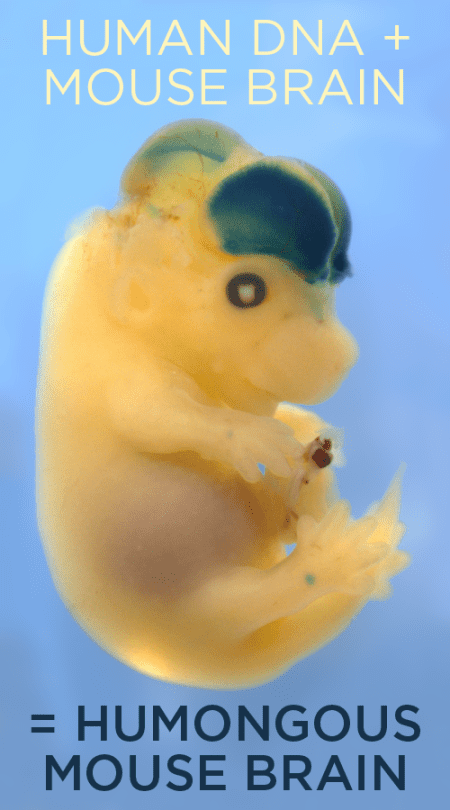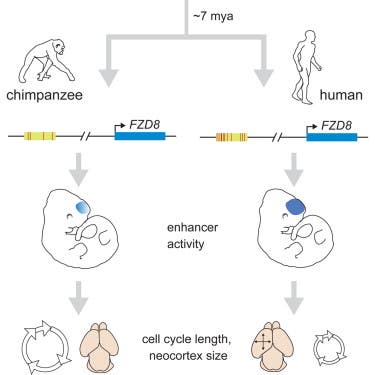In the quest to understand what are the crucial differences between human and chimpanzee brains, scientists have isolated a stretch of DNA, once thought to be “junk”, near a gene that regulates brain development in mice. The engineered mouse embryos grew significantly larger brains. Those which received human brain DNA strands had 12% larger brains than those bred with chimp brain DNA. Research like this, though ethically controversial, might help identify which DNA sequences give a brain human characteristics, but also aid in findings treatment or cures for brain diseases like Alzheimer’s.
It’s a common fact thrown about that humans and chimps, often called our cousins, share 95% of their DNA. Though it’s easy to see a piece of you in the eyes of a chimp, we humans and chimps are quite different. Basically, we’re more complex, something that can be easily interpreted from brain size. Depending on the specimen, chimp brains are two to four times as small as the human kind. Debra Silver, a neurobiologist at Duke University Medical School, is studying DNA code that is different between the two or unique to each species in an attempt to piece those pieces of DNA that made humans the dominant species on Earth. For, make no mistakes, we owe it all to our superior intellect.
“We went through those and picked out ones that seemed to be likely to be regulating gene activity in a developing brain,” explains Silver.
The researchers focused on a particular DNA stretch which looked promising since it was located near a gene known to be involved in brain development. So, to see what could happen, the researchers added the chimp version of the DNA to mouse embryos. Then, in other mouse embryos, they added the human DNA.
“What we discovered is that the human DNA turned on gene activity in neural stem cells, and these are cells which produce the neurons of our cerebral cortex,” says Silver.
All the mice grew bigger brains than they would have normally, but those embryos infused with the human DNA had a significantly bigger brain than the rest – 12% larger than those bred using the chimp variety of the DNA, according to the paper published in Current Biology. What’s interesting is that this particular DNA code was thought to be “junk”, a slag for DNA that doesn’t code proteins. Evidently, discoveries like these overthrow this common assumption that see “useless” DNA as serving no purpose. The genome – the entire DNA sequence of an organism – is made up of a small number of genes. The rest or bulk of it is comprised of DNA that regular gene expression. Code that turns a gene on or off, and more often than not it’s gene expression that make all the difference between a human, chimp or mouse, and not the presence of a gene itself.
“We have very little scientific information about the actual functions of those regions,” says Katie Pollard, who studies human and chimp DNA at the Gladstone Institutes and the University of California, San Francisco.
Most of the genetic differences between humans and chimps are actually found in the so-called junk DNA, Pollard notes. “While it’s now pretty easy to find the genetic differences, it’s very challenging to figure out exactly whether those differences made a change in a trait, and why.”
This new study, says Pollard, “is helping to try to bridge that gap.”
But will the big-brained mice be smarter? It’s very difficult to gauge this kind of cognitive enhancement, but the researchers are most excited about probing this idea once the pups reach adulthood. Ideally, the best results would be seen if scientists would tinker with switching off and on genes in human and chimpanzee embryos, but this would be dubiously unethical. Instead, Pollard and colleagues are keeping their eyes on petri dishes.
“We can now actually generate the equivalent of embryonic brain cells and tissues that are human or chimpanzee,” says Pollard. “And, using genome engineering techniques, we can start to study the effects of switching the human and the chimp sequences in these primate cell lines.”
Could this sort of research render super animals with human-like cognition? Well, according to those involved something out of Planet of the Apes is why too far ahead, if not impossible. But while we won’t make mice that can speak any time soon, this sort of tinkering with the brains of nonhuman primates or other reasonably intelligent animals, like pigs, is seemingly unethical and merits particular attention.
“The prospect of, sort of, tearing down the barriers between humans and other nonhuman species in ways that really threaten our sense of ourselves as special is disturbing,” Ruth Faden points out, who directs the Johns Hopkins Berman Institute of Bioethics.











